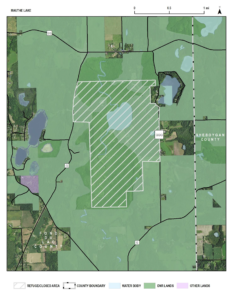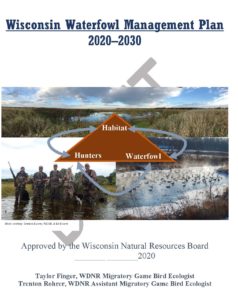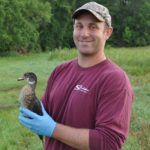By Taylor Finger, WDNR Migratory Game Bird Ecologist
This article originally appeared in Wisconsin Waterfowl Association’s August, 2019 eNewsletter.
The WI DNR has been working on updating and simplifying a rule that covers refuges and waterfowl closed areas. This has been a task that the WI DNR has been wanting to tackle and is overdue. Over the past year and a half we have evaluated all of the refuges (public and private), as well as all of the closed areas throughout the state of Wisconsin and what we found was that there was definitely room for consolidation and simplification.
To the best of our knowledge, there has not been a wholistic review of refuges and closed areas in nearly 40 years and, as you can image, a lot has changed in Wisconsin in 40 years. What we found was that, in many cases places that were once considered essential refuges or areas for migrating waterfowl, are no longer biologically functioning as they were intended.
We also found inconsistencies across state managed properties that made it extremely confusing for hunters and recreationists, as well as detrimental to staging and migrating waterfowl. So, through this process we evaluated each property and their refuge/closed area designation and asked WI DNR property managers and specialists whether the area was still biologically functioning as it was intended and, if so, to choose a designation from a more consolidated list of options.
Similarly, we contacted all of the private land owners and entities and asked them if they were even aware their property was designated a refuge or closed area, and what we found was that most people were not aware, or that they wished to be able to hunt, trap or otherwise have access to a number of recreation activities on their own property which they currently were not allowed to do.
 So throughout this process we made the decision to remove all privately owned, non WI DNR managed lands from this rule, as landowners and private entities have the authority to limit access as they see fit and do not need the WI DNR to regulate this type of activity. On the lands that are owned and managed by the WI DNR, we asked staff to make the decision to remove the property as a refuge/closed area if it biologically no longer fit the definition. If it still did, they had a list of designations to choose from. In some cases the restrictions and regulations didn’t change at all, in some cases we liberalized recreational opportunity and in other cases we better protected the quality areas that still provide protection for staging and migrating waterfowl.
So throughout this process we made the decision to remove all privately owned, non WI DNR managed lands from this rule, as landowners and private entities have the authority to limit access as they see fit and do not need the WI DNR to regulate this type of activity. On the lands that are owned and managed by the WI DNR, we asked staff to make the decision to remove the property as a refuge/closed area if it biologically no longer fit the definition. If it still did, they had a list of designations to choose from. In some cases the restrictions and regulations didn’t change at all, in some cases we liberalized recreational opportunity and in other cases we better protected the quality areas that still provide protection for staging and migrating waterfowl.
Additionally, as part of this process we updated and provided consistent maps for all of our refuges and closed areas. As I stated, some of these have not been reviewed for 40 years and mapping technology has come a long way since then. So as you can image, this process has taken a lot of work and commitment from all WI DNR staff and we are nearing the finish line. I am holding public hearings the week of July 29th throughout the state, you can find the locations here (https://dnr.wi.gov/calendar/hearings/index.asp), the public comment period is open through August 16th and please be sure to send all public comments to Taylor Finger either via phone (608-266-8841) or email (Taylor.Finger@wisconsin.gov). The proposed rule, as well as a document that walks folks through each property and the changes that were made is available here (https://dnr.wi.gov/news/input/proposedpermanent.html – scroll down to WM-24-18). As the Migratory Game Bird Specialist, I want to share a couple of key things to consider when reviewing this rule if you so choose to comment:
- These new designations consolidate and simplify regulations for nearly all recreationists. Through this process we were able to open up recreational opportunities on over 75% of our managed properties at a time when the need for protection of migratory waterfowl is minimal.
- We were better able to limit the amount of disturbance on our quality waterfowl staging and migrating areas during a time when it is important to provide refuge and protection for these birds, and
- We have provided much more accurate and consistent maps for all of our managed properties across the state.
 On another note that is no less important, the WI DNR is going to be holding public meetings to collect public input on the next iteration of the Wisconsin Waterfowl Management Plan. The previous management plan ran through 2018, and now is the time for an update. This plan lays out updated goals and objectives and will help to direct how the WI DNR and our partners will manage waterfowl for the next decade in the state of Wisconsin. The development of this plan has been one of the more enjoyable projects of my career and could not have been achieved without the considerable help from our partners and conservation organizations. This plan was developed with the help from WI DNR staff from across the state, Wisconsin Conservation Congress, Wisconsin Wildlife Federation, Wisconsin Waterfowl Association, Ducks Unlimited, La Crosse County Conservation Alliance, Green Bay Duck Hunters Association, Great Lakes Indian Fish and Wildlife Commission, United State Fish and Wildlife Service and Hunters Rights Coalition. This truly was a team effort and this management plan is more than the WI DNR’s plan; it is everyone’s plan as we can’t make a difference if we only manage waterfowl on property the state owns. We all have to work together to achieve the goals and objectives outlined in this plan which is available on our waterfowl webpage and at this link (https://dnr.wi.gov/topic/hunt/documents/WisconsinWaterfowlPlan.pdf) and please be sure to submit any comments or suggestions on the plan to Taylor Finger via phone (608-266-8841) or email (Taylor.Finger@wisconsin.gov).
On another note that is no less important, the WI DNR is going to be holding public meetings to collect public input on the next iteration of the Wisconsin Waterfowl Management Plan. The previous management plan ran through 2018, and now is the time for an update. This plan lays out updated goals and objectives and will help to direct how the WI DNR and our partners will manage waterfowl for the next decade in the state of Wisconsin. The development of this plan has been one of the more enjoyable projects of my career and could not have been achieved without the considerable help from our partners and conservation organizations. This plan was developed with the help from WI DNR staff from across the state, Wisconsin Conservation Congress, Wisconsin Wildlife Federation, Wisconsin Waterfowl Association, Ducks Unlimited, La Crosse County Conservation Alliance, Green Bay Duck Hunters Association, Great Lakes Indian Fish and Wildlife Commission, United State Fish and Wildlife Service and Hunters Rights Coalition. This truly was a team effort and this management plan is more than the WI DNR’s plan; it is everyone’s plan as we can’t make a difference if we only manage waterfowl on property the state owns. We all have to work together to achieve the goals and objectives outlined in this plan which is available on our waterfowl webpage and at this link (https://dnr.wi.gov/topic/hunt/documents/WisconsinWaterfowlPlan.pdf) and please be sure to submit any comments or suggestions on the plan to Taylor Finger via phone (608-266-8841) or email (Taylor.Finger@wisconsin.gov).
Public meetings will be held at the following locations starting at 6 pm:
- Tuesday August 13, 6 p.m., Eau Claire, Wis. – Wisconsin DNR Service Center, Rooms 185, 1300 W. Clairemont Ave. Eau Claire, WI 54701;
- Wednesday August 14, 6 p.m., Green Bay, Wis – Barkhausen Waterfowl Preserve, 2024 Lakeview Dr., Suamico, WI 54173; and
- Thursday August 15, 6 p.m., Madison, Wis – 3911 Fish Hatchery Rd, Fitchburg, WI 53711

